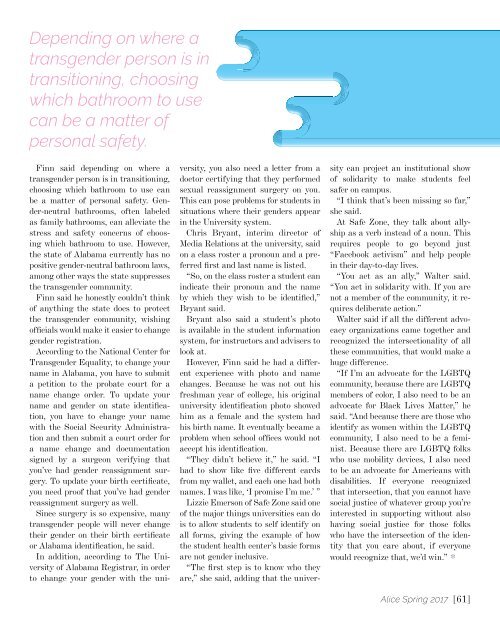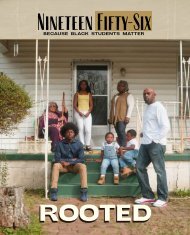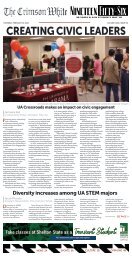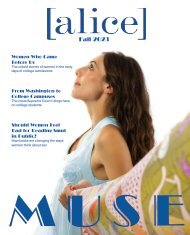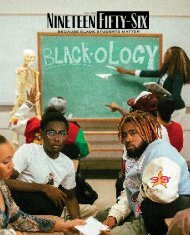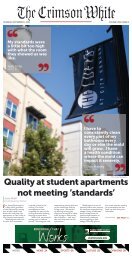Alice Vol. 2 No. 2
Published by UA Student Media in Spring 2017.
Published by UA Student Media in Spring 2017.
Create successful ePaper yourself
Turn your PDF publications into a flip-book with our unique Google optimized e-Paper software.
Depending on where a<br />
transgender person is in<br />
transitioning, choosing<br />
which bathroom to use<br />
can be a matter of<br />
personal safety.<br />
Finn said depending on where a<br />
transgender person is in transitioning,<br />
choosing which bathroom to use can<br />
be a matter of personal safety. Gender-neutral<br />
bathrooms, often labeled<br />
as family bathrooms, can alleviate the<br />
stress and safety concerns of choosing<br />
which bathroom to use. However,<br />
the state of Alabama currently has no<br />
positive gender-neutral bathroom laws,<br />
among other ways the state suppresses<br />
the transgender community.<br />
Finn said he honestly couldn’t think<br />
of anything the state does to protect<br />
the transgender community, wishing<br />
officials would make it easier to change<br />
gender registration.<br />
According to the National Center for<br />
Transgender Equality, to change your<br />
name in Alabama, you have to submit<br />
a petition to the probate court for a<br />
name change order. To update your<br />
name and gender on state identification,<br />
you have to change your name<br />
with the Social Security Administration<br />
and then submit a court order for<br />
a name change and documentation<br />
signed by a surgeon verifying that<br />
you’ve had gender reassignment surgery.<br />
To update your birth certificate,<br />
you need proof that you’ve had gender<br />
reassignment surgery as well.<br />
Since surgery is so expensive, many<br />
transgender people will never change<br />
their gender on their birth certificate<br />
or Alabama identification, he said.<br />
In addition, according to The University<br />
of Alabama Registrar, in order<br />
to change your gender with the university,<br />
you also need a letter from a<br />
doctor certifying that they performed<br />
sexual reassignment surgery on you.<br />
This can pose problems for students in<br />
situations where their genders appear<br />
in the University system.<br />
Chris Bryant, interim director of<br />
Media Relations at the university, said<br />
on a class roster a pronoun and a preferred<br />
first and last name is listed.<br />
“So, on the class roster a student can<br />
indicate their pronoun and the name<br />
by which they wish to be identified,”<br />
Bryant said.<br />
Bryant also said a student’s photo<br />
is available in the student information<br />
system, for instructors and advisers to<br />
look at.<br />
However, Finn said he had a different<br />
experience with photo and name<br />
changes. Because he was not out his<br />
freshman year of college, his original<br />
university identification photo showed<br />
him as a female and the system had<br />
his birth name. It eventually became a<br />
problem when school offices would not<br />
accept his identification.<br />
“They didn’t believe it,” he said. “I<br />
had to show like five different cards<br />
from my wallet, and each one had both<br />
names. I was like, ‘I promise I’m me.’ ”<br />
Lizzie Emerson of Safe Zone said one<br />
of the major things universities can do<br />
is to allow students to self identify on<br />
all forms, giving the example of how<br />
the student health center’s basic forms<br />
are not gender inclusive.<br />
“The first step is to know who they<br />
are,” she said, adding that the university<br />
can project an institutional show<br />
of solidarity to make students feel<br />
safer on campus.<br />
“I think that’s been missing so far,”<br />
she said.<br />
At Safe Zone, they talk about allyship<br />
as a verb instead of a noun. This<br />
requires people to go beyond just<br />
“Facebook activism” and help people<br />
in their day-to-day lives.<br />
“You act as an ally,” Walter said.<br />
“You act in solidarity with. If you are<br />
not a member of the community, it requires<br />
deliberate action.”<br />
Walter said if all the different advocacy<br />
organizations came together and<br />
recognized the intersectionality of all<br />
these communities, that would make a<br />
huge difference.<br />
“If I’m an advocate for the LGBTQ<br />
community, because there are LGBTQ<br />
members of color, I also need to be an<br />
advocate for Black Lives Matter,” he<br />
said. “And because there are those who<br />
identify as women within the LGBTQ<br />
community, I also need to be a feminist.<br />
Because there are LGBTQ folks<br />
who use mobility devices, I also need<br />
to be an advocate for Americans with<br />
disabilities. If everyone recognized<br />
that intersection, that you cannot have<br />
social justice of whatever group you’re<br />
interested in supporting without also<br />
having social justice for those folks<br />
who have the intersection of the identity<br />
that you care about, if everyone<br />
would recognize that, we’d win.” *<br />
<strong>Alice</strong> Spring 2017 [61]


